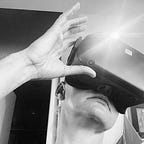The Social Benefits of VR Training
Monica is a young mother at the end of her rope. She’s cobbling together a living at minimum wage jobs, crashing with her unemployed boyfriend, who might have anger and substance abuse issues, and caring for a young child with asthma and a baby who is failing to thrive. On top of that, her ex-boyfriend has called children’s services to report her for negligence, one more stressor in a fractured and chaotic life.
Luckily, Monica gets a caseworker who cares, asks the right questions, and is understanding and empathetic. Things start to move in the right direction…and then, that case worker quits, and is replaced by another one. And even if this case worker happens to be just as good as the first one, the clock has essentially reset to zero, and the new person needs to gain Monica’s trust again. And the cycle continues.
While Monica is a composite character in a VR training piece, this situation was the reality for many families in Indiana. Case worker turnover was 50% per year, and the state was spending $72 million annually to replace those who departed. Frustrated, the CIO of Indiana’s Child Welfare agency turned to a VR training that Friends With Holograms built for Accenture — and saw the turnover rate drop to 19%, saving millions of dollars in the process.
Virtual reality is still often associated with games and entertainment, and training for hard skills. And while those are all fantastic and worthwhile use cases, VR can also be used for soft skills training, particularly in areas where a high degree of emotional intelligence is needed.
The benefits of training in VR go far beyond ROI, although just one look at the numbers in the above case ought to convince you that that alone is a reason to invest. Saving taxpayers millions of dollars annually is a pretty hard proposition to turn down. But beyond just the bottom line, VR benefits workers who are often underpaid and undertrained.
High employee turnover rates are endemic across industries but often highest in those where workers are treated and paid the worst. A fast casual food chain recently reported it had over 100% turnover annually, and while some of that is due to seasonal fluctuations in the workforce, more of it is due to people being frustrated and quitting to make lateral moves to other restaurants. This is a problem for the workers, who teeter on the edge of precarity and don’t have the training to do their jobs well; the owners, who have to spend outsize time and money replacing workers; and the customers, who have negative experiences being served by a poorly trained and incentivized workforce.
Now imagine the alternative — workers, who are well trained using technology that has been proven to be more effective than other methods of training, sticking around long enough to rise through the ranks and form bonds with customers. Employers who see a massive reduction in turnover costs and have a happier workforce. And customers who get consistency and great service every time, who rave about the outlet and bring friends, growing the business.
In the coming weeks and months, we’ll use this space to talk about why VR training is not just good for business but good for society. We’ll explore how everyone from frontline workers to senior managers can benefit from this training, and how it will shape the workforce of the future. And we’ll break down the best practices we’ve learned creating award-winning, socially resonant VR training programs that deliver real results.
We are always looking for new partners to work with — drop us a line here if you’re interested.
